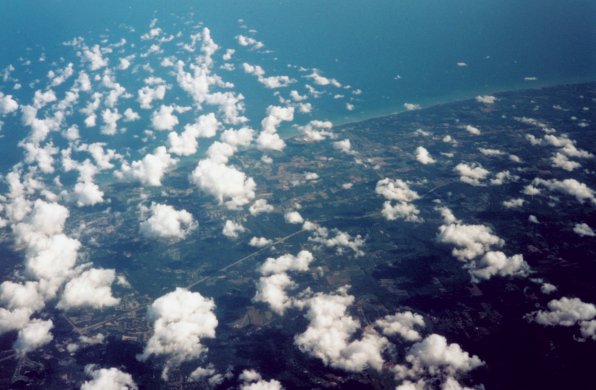SKYLIGHTS

Photo of the Week.. Planet Earth: Ranks of clouds
line up toward Lake Erie at the top.
Astronomy news for the week starting Friday, January 18, 2002.
We begin the week with the Moon at its farthest from the Earth, at
apogee, as it heads toward its first quarter, which it will reach
on Monday, January 21st, roughly the time it rises in North
America. The night of Friday, the 18th, watch as the Moon passes
to the south of Mars. Set below the Circlet of Pisces, the red planet is practically on the
ecliptic, the apparent path of the Sun. The lunar orbit is rather tilted,
however, and on the 18th, the Moon will be about as far south of
the ecliptic as it can get, and hence will not come close to
covering, or occulting, Mars.
As the Moon orbits, it will approach the ecliptic path, and as it
goes over the top to the north in Taurus and Gemini,
will in fact occult first Saturn and then Jupiter on Thursday the
24th and Saturday the 26th respectively. The events happen in the
daytime in the Americas, however. As a result, the Moon will be to
the west of Saturn the night of Wednesday, the 23rd, and to the
east of it the following evening. Saturn is now just to the east
of the Hyades in Taurus. The
juxtaposition of the growing gibbous Moon, the Hyades with Aldebaran, Saturn, and the Pleiades just to the north, will
make an especially grand sight, one not to be missed. And don't
forget Jupiter, not far to the east. Both giant planets are well
up in the east by sunset. Saturn crosses the meridian to the south
around 8:30 PM, while Jupiter follows two hours later. If you have
access to a telescope, be sure to take a look at both of them.
Saturn's rings, made of countless small ice-coated rocks, are wide
open and an easy sight, while on Jupiter you can trace out dusky
cloud belts formed within the planet's ammonia clouds. Jupiter's
four bright moons -- in order outward Io, Europa, Ganymede (a bit
bigger than Mercury, the largest moon in the Solar System), and
Callisto -- are visible even in binoculars. In even the smallest
telescope, Saturn's big moon Titan will pop out at you. Titan is
covered with a thick atmosphere, and is suspected of having an
ocean made of methane and ethane. We will know better when the
Cassini probe gets there in 2004.
The sight on Wednesday and Thursday nights gets even better when
you take into account the surrounding brilliant winter
constellations. Down and to the left of Saturn and the Moon find
wonderful Orion, the giant hunter
of ancient Greek mythology. Above the Moon will be Auriga, the Charioteer, with bright
Capella and the three-star
triangle called "the Kids." To the left of Orion bark his two
"hunting dogs," Canis Major (the
larger) with brilliant Sirius
below, Canis Minor, with Procyon, above. Taken together,
there are few better celestial sights.







